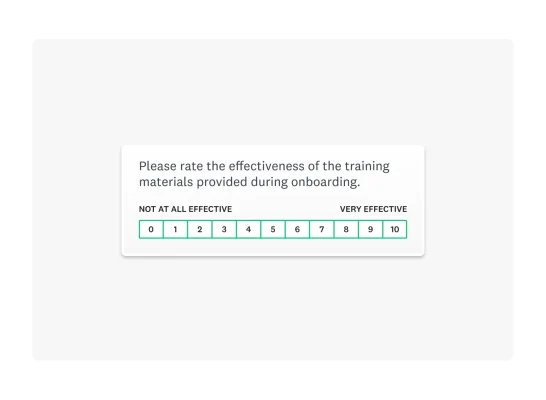How to start an employee onboarding program [2025 guide]
Learn how to integrate new hires into your organization with effective employee onboarding.

Employee onboarding serves as a critical component of the employee lifecycle. It sets the tone for the rest of the employee experience, affecting retention and satisfaction.
A subpar onboarding process can lead to poor employee performance, attrition, and lower job satisfaction. Effective employee onboarding ensures that new hires have the resources and support they need to thrive.
Keep reading to learn how to build an employee onboarding program to improve retention and performance.
What is employee onboarding?
Employee onboarding is the process human resource professionals use to integrate new employees into an organization.
Onboarding equips new hires with the tools, resources, and information essential for success in their roles. It often encompasses orientation, training, and introductions to foster familiarity with company culture, policies, and team dynamics.
How to build an employee onboarding program
Implementing an employee onboarding program fosters confidence in new hires as they begin their roles and supports long-term retention initiatives. In fact, a study found that effective employee onboarding boosted retention rates by 82%.
Let’s dive into how to create an employee onboarding program to fuel your business growth in 2025.
Hiring process
HR professionals can create a seamless transition between recruitment and employment by starting the onboarding process early. Early action ensures new hires feel supported from the beginning, setting the tone for their overall company experience. Additionally, a smooth transition supports brand reputation.
You can showcase company culture during the final interview through presentations or video testimonials. This approach provides candidates with a clearer understanding of the workplace culture, ensuring it is the right fit for them. This minimizes employee turnover by ensuring new hires understand what to expect.
Job offer
Once an employee accepts a job offer, kick onboarding into full gear. Communicating expectations before a new hire’s first day makes starting a new job less intimidating.
Start onboarding early by sending the following materials.
- Welcome kit: A welcome kit can include a personalized welcome letter, the employee handbook, and a first-day itinerary.
- Company swag: Care packages with company swag are especially popular among remote teams. They are a thoughtful way to integrate new hires into the company culture immediately.
- Handwritten note: A handwritten note is a personal touch that can increase a sense of belonging. This proactive outreach from HR makes a big difference in a new hire’s first impression of the company.
First week
Employees should be assigned a work buddy, meet the team, and complete training modules during the first week.
Assign a work buddy
During their first week, employees should be paired with a designated work buddy who can help guide them through onboarding. This buddy will serve as a point of contact for questions and provide insights into the company culture.
Meet the team
Team introductions should occur immediately in a group meeting or on an individual basis. Introductions can help break the ice, foster connections, and build relationships.
Fill out onboarding paperwork
Have the employees fill out the necessary forms and paperwork. Some tasks you may ask a new hire to complete include:
- Creating a company email address
- Filling out tax forms
- Setting up direct deposit
- Signing handbook acknowledgment forms
- Completing noncompete or nondisclosure agreements
Streamline the process by sending forms via email and having employees sign them electronically.
Complete training modules
New hires must also complete all required training modules this week, which will equip them with the necessary knowledge and skills to thrive in their roles.
Subsequently, training surveys can be used to collect employee feedback on content clarity, lesson relevance, and new hire preparedness to improve your training.
Engaging in these activities will help ensure a smooth transition into the workplace and promote a collaborative environment.
Related reading: 6 training materials to use today (and why)
Make time for job shadowing
Job shadowing is an effective means of acclimating a new hire to their work environment. Sessions give new hires knowledge of how their role impacts other team members. Schedule job shadowing sessions with team members across relevant departments.
Start introducing work
Gradually, begin introducing work during the employee’s first week. Start with simpler tasks that help new hires practice using key tools and project management systems.
30-day onboarding check-in
Human resource professionals or direct managers should conduct a check-in after 30 days of onboarding to evaluate training effectiveness and address any concerns.
- How comfortable do you feel going to your manager with questions about your work?
- Do you feel that you have been given the training and resources you need to be successful in your role?
- To what extent do you understand what’s expected of you in your first 90 days?
By asking the right questions, HR professionals and team leaders can continuously improve the onboarding process for new employees.
60-day employee check-in
After 60 days, another check-in should be conducted. Our 60-day Onboarding Survey Template was designed to help HR teams assess how new employees are settling.
This survey template asks:
- Do you feel you are getting too much, not enough, or the right amount of feedback from your manager?
- Do you feel that your job responsibilities align with your expectations based on the job description?
- How valued do you feel at work by your co-workers and team leaders?
The 60-day employee check-in creates an engaging onboarding experience for recent team additions.
90-day check-in
By 90 days, employees should settle into their roles and get into the swing of things. These regular check-ins help employees feel supported and can promote long-term success.
When new employees don’t feel supported by their managers, they may find it difficult to complete tasks effectively. Regular check-ins allow employees to ask questions and receive feedback. Managers can also encourage employee development by offering performance feedback and guidance during these check-ins.
The 90-day Onboarding Survey Template asks:
- How satisfied are you with your new role so far?
- Are you now working on your job tasks fully independently, mostly independently, or with frequent support?
- How optimistic do you feel about your career growth within your new role?
By this point, new employees should be given learning and development opportunities to increase their engagement and support growth and skill development.
Employee satisfaction surveys allow human resource teams to continuously improve the onboarding process. The data and insights gleaned from employee feedback surveys are invaluable when evaluating the effectiveness of your onboarding process.
Employee onboarding best practices
Follow these employee onboarding best practices to create an effective program.
Establish onboarding milestones
Establishing onboarding milestones helps guide employees through their journey and measure progress.
Some onboarding milestones you should consider include the following:
- Welcome and orientation: Make a positive impression, introduce the team, overview the company’s mission, and build excitement.
- Role and team integration: After the first week, new hires should understand their job duties and meet their teammates. Schedule meetings with key colleagues and provide hands-on training through job shadowing.
- Performance check-ins: Regular check-ins evaluate an employee’s progress in acclimating to their new role. During performance check-ins, measure the employee’s comfort level, provide answers to questions, and review goals.
- 90-day probationary period evaluation: At 90 days, the employee should meet specified milestones marking the end of the probationary period.
- First work anniversary: The first work anniversary is a milestone worth celebrating. Consider giving employees a gift on their work anniversaries to show your appreciation.
Celebrate small wins to keep employees satisfied and excited about their progress at work.
Leverage employee onboarding templates
Use employee onboarding surveys to collect feedback about their experiences. HR teams use these insights to improve the onboarding process for future hires.
SurveyMonkey offers several employee onboarding survey templates to streamline the process. Check out these survey templates:
These expertly written templates make gathering onboarding feedback simple. Our survey templates allow you to customize and brand them with your company’s colors and logo.
How to use employee onboarding surveys

Employee onboarding surveys assess the effectiveness of your onboarding program. Survey results can highlight areas for improvement in the onboarding process. Select the survey template that most closely aligns with your onboarding milestone.
Send the survey to new employees at strategic points throughout the onboarding process, like the 30-, 60-, and 90-day marks. Additionally, you can gauge a new employee’s knowledge by sending a pre-training survey. Encourage candid responses by letting employees know answers are confidential and are only used to enhance the onboarding experience.
Once you have collected feedback, review and analyze the data to find patterns and trends. The surveys yield both quantitative and qualitative data to help you understand what’s working well (and not so well). Use the data to refine onboarding training materials and address support gaps. Foster a culture of frequent feedback and continuous improvement by using surveys.
The benefits of employee onboarding surveys
Employee onboarding surveys are powerful tools for elevating the onboarding experience. The benefits include:
- Better communication and feedback loops: Utilizing surveys during the onboarding process improves communication and feedback loops. Surveys allow new employees to express their concerns, experiences, and challenges during onboarding. With this feedback, human resource departments can address potential issues, reducing early turnover.
- Measuring effectiveness: Employee onboarding surveys also measure the effectiveness of the current process. Employees give feedback on what parts they like and don’t like to help HR teams make adjustments. Surveys reveal parts of the training that lacked resources or were confusing. This feedback ensures areas for improvement are addressed promptly before causing long-term effects.
- Building employee trust: Surveys build employee engagement and trust. Employees who feel listened to and valued are likelier to stick around longer. If they see feedback acted upon, this further validates the company cares about their opinions. High employee engagement promotes meaningful employee contributions and productivity.
- Standardization and benchmarking: When teams consistently send surveys, they can analyze trends over time and establish benchmarks. This assists human resource departments in continuously updating the onboarding program, improving its effectiveness.
Pay attention to remote employees
Remote workers often have a different experience than in-office employees and may need help to acclimate. Therefore, HR teams should implement specific measures to ensure a positive digital onboarding experience for remote employees.
- Host a virtual welcome session: Make sure to host a welcome session for new hires to meet the team via a virtual meeting.
- Email a preboarding packet: Preboarding remote employees creates a smooth transition during the first week of work.
- Assign a virtual work buddy: A virtual work buddy can serve as a guide and friendly face for new remote employees.
- Schedule frequent check-ins: Check in regularly with remote employees to ensure they have the resources to succeed.
- Encourage team interactions: Boost camaraderie and build stronger connections by encouraging informal team interactions.
Create an employee onboarding training
Human resource teams should conduct training for managers, work buddies, and team leads involved in employee onboarding. An onboarding training should include an employee onboarding checklist specific to each stakeholder. This training keeps everyone on the same page to best prepare new employees at the company.
Employee onboarding FAQs
- How is employee onboarding related to retention?
- How do I engage remote employees in onboarding?
Improve employee onboarding with surveys
Effective employee onboarding is the key to employee success. Prioritize creating a strong employee onboarding program to promote retention and boost productivity among workers.
SurveyMonkey helps HR teams streamline onboarding and gather employee feedback to continuously update their programs. Get started by signing up for a free SurveyMonkey account today.